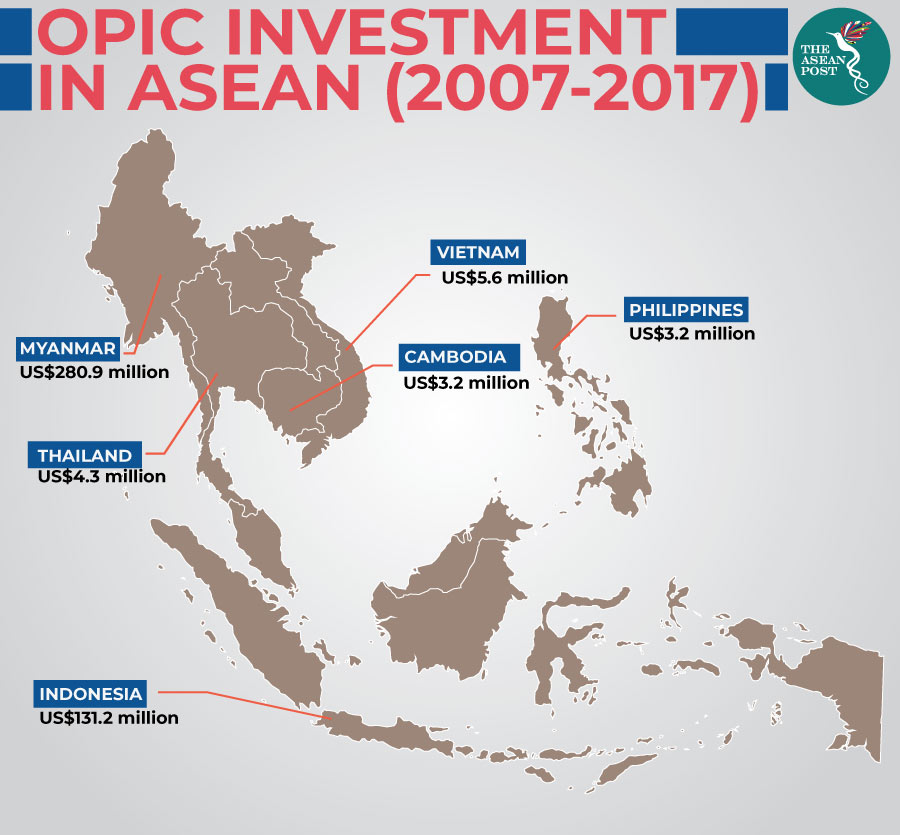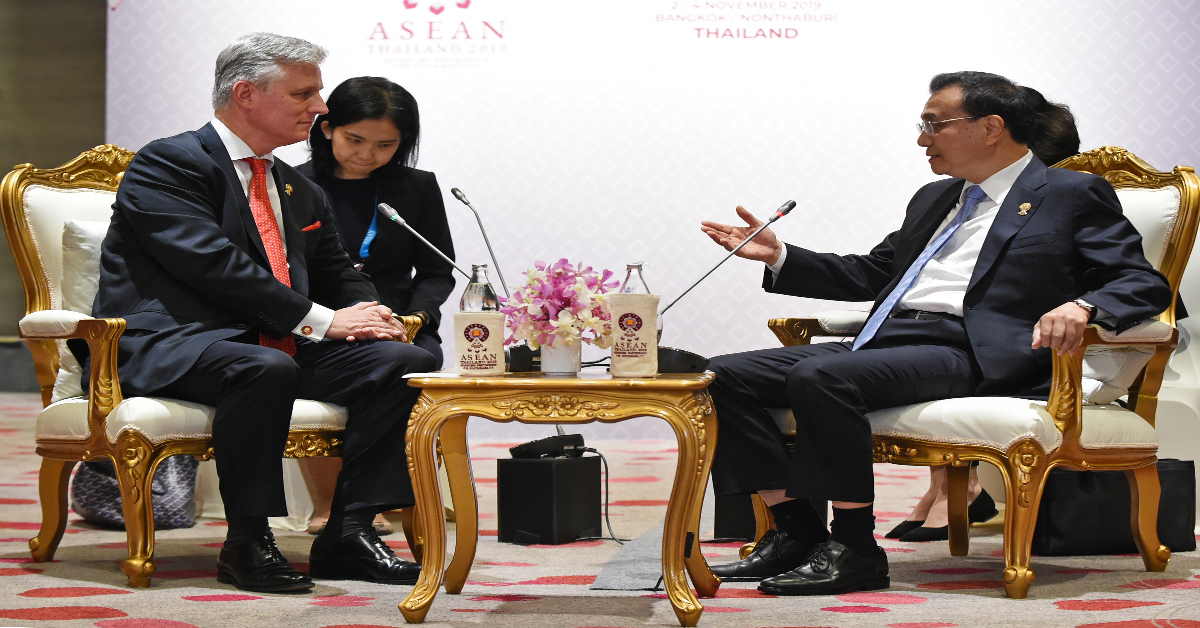The unveiling of the United States’ (US) Blue Dot Network raises several questions about the country’s commitment to ASEAN after signs of fading interest in the region.
Seen as a counterbalance to China’s extensive Belt and Road Initiative (BRI), the Blue Dot Network aims to promote sustainable infrastructure development in the Indo-Pacific region and beyond. But with no ASEAN leaders picking up the cause so far, it does not look like the network will gain much traction in the region.
US influence had been on the wane long before President Donald Trump took office in January 2017, with Dr Tang Siew Mun, Head of the ASEAN Studies Centre at Singapore’s ISEAS-Yusof Ishak Institute, arguing that the US “has been playing catch-up to China’s charm offensive since the turn of the new century.”
ASEAN Summit no show
Rising nationalism, mounting protectionism and a 16-month trade war with China that has hurt the global economy has led to increasing frustration with recent US’ foreign policy, feelings which were heightened when Trump skipped the ASEAN Summit in Bangkok earlier this month after also missing last year’s event in Singapore.
The ASEAN Summit provided Trump with the perfect platform to pitch the Blue Dot Network to the leaders of the 10 ASEAN countries.
Instead, he sent National Security Adviser Robert O'Brien and Commerce Secretary Wilbur Ross in his place – saying he was tied up with election campaign events in the US.
In an apparent snub at Trump’s decision not to travel to the Thai capital, the US-ASEAN Summit was only attended by the heads of states of three ASEAN members.
One ASEAN diplomat said it “was not appropriate for ASEAN to send leaders when the US representation is not on parity” and another refuted claims of a boycott – instead saying that “other leaders have other meetings to attend to.”
Clearly, the time was not right for the US to introduce any regional initiatives – especially one that provided so few concrete details other than it would be led by the US’ Overseas Private Investment Corporation (OPIC), Australia’s Department of Foreign Affairs and Trade (DFAT) and Japan Bank for International Cooperation (JBIC).

Despite that, the US chose to roll out its Blue Dot Network at the US-ASEAN Summit – with the word ‘trust’ a crucial part of the narrative.
“The Blue Dot Network not only creates a solid foundation for infrastructure global trust standards but reinforces the need for the establishment of umbrella global trust standards in other sectors,” said US Department of State Under Secretary for Economic Growth, Energy and the Environment, Keith Krach, during the launch.
“Such global trust standards, which are based on respect for transparency and accountability, sovereignty of property and resources, local labour and human rights, rule of law, the environment, and sound governance practices in procurement and financing, have been driven not just by private sector companies and civil society but also by governments around the world,” added Krach.
TPP troubles
Is ASEAN ready to place its trust in another multilateral economic treaty with the US?
One only has to look back to the Trans Pacific Partnership (TPP), a free-trade pact that was once billed as the world’s biggest, to see how such a partnership may turn sour.
The trade deal was on the cards since 2008 and was set to integrate the ASEAN markets of Brunei, Malaysia, Singapore and Vietnam with major global economies such as the US, Japan, Australia and Canada.
Although Trump abandoned the TPP in January 2017 in one of his first moves as president, uncertainty surrounding the trade deal was a concern even before Trump took over the White House.
Perhaps Singapore’s Prime Minister Lee Hsien Loong summed up his counterparts’ sentiments about the US’ possible withdrawal when he asked in 2016: “How can anybody believe in you anymore?”
But with the BRI now having spread its arms as far as Italy and Germany, the US feels that it has to act quickly to counter the ambitious trade and infrastructure network which Chinese President Xi Jinping announced in 2013.
Chad Sbragia, the US Deputy Assistant Secretary of Defense for China, recently called for “diplomatic, economic and security efforts to respond to China’s Belt and Road activities,” stressing that they have to be integrated better than they were in the past.
While the Blue Dot Network will have no lending function of its own and serve instead as a catalyst for private finance, the BRI, in comparison, is bank-rolled by Chinese state-owned banks and companies – offering relatively poorer countries with some welcome investment and easy loans, albeit at high interest rates.
Crucially, unlike the Blue Dot Network, the BRI does not come with a host of pre-conditions such as respect for “local labour and human rights, rule of law and the environment” – all areas which ASEAN will have a tough time trying to meet US standards.
Money talks
More than 150 countries and international organisations have signed BRI cooperation documents with China according to Chinese state media agency Xinhua in April. Trade volume between China and other BRI countries amounted to US$6.47 trillion from 2013-2018, and China’s investment in BRI projects in these countries has exceeded US$90 billion.
As Peter McCawley, an economics professor at the Australian National University wrote in a publication for Australian think tank Lowy Institute earlier this week, the US has been unable to compete with China’s programs in part because US foreign aid programs have been reduced in recent years.
Instead of trying to match China’s scale of spending, McCawley said the US is arguing that the quality of investments in infrastructure is just as important as the quantity.
“The new Blue Dot Network, therefore, is best seen as part of the broader US game plan of trying to persuade developing countries in Asia that they should not rely on Chinese funds for infrastructure,” said McCawley, a former Executive Director at the Asian Development Bank (ADB).
“On one hand, it’s fine for the US to emphasise the need for quality, but the level of spending that donor countries offer is important as well. Donors need to put their money where their mouth is.
“After all, a road is a road, whether it is built with US or Chinese money. At present, it seems that the Chinese are prepared to fund the construction of infrastructure in Asia, while the US is not.”
Related articles:
ASEAN growth slower than forecasted
